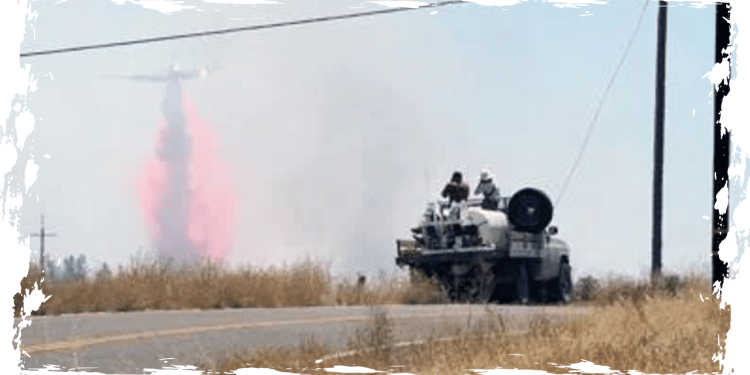The wildfires in the panhandle earlier this year are expected to be the most expensive in the history of the state, as they ravaged over 1.2 million acres.
The state investigation uncovered what appears to be significant shortcomings in the response efforts, including the aerial response. These failures, if properly addressed, could have potentially prevented the fires from spreading further.
According to a report released by the House General Investigating Committee, the projected economic losses are estimated to reach a staggering $1 billion. This is in addition to the initial estimated agricultural losses, which amount to $123 million, and the losses suffered by the cattle industry, totaling $27 million. The impact of these losses is expected to have far-reaching consequences on the affected sectors.
In late February, a devastating wildfire known as the Smokehouse Creek Fire engulfed over one million acres in Hutchinson County, making it the largest wildfire in the history of Texas, as reported by The Center Square. Consequently, Governor Greg Abbott had to declare a state of disaster for 60 counties due to the multiple wildfires that were occurring.
House Speaker Dade Phelan, a Republican from Beaumont, took the initiative to establish a five-member committee tasked with investigating the root cause of the devastating wildfires. To spearhead this crucial endeavor, state Rep. Ken King, also a Republican hailing from the panhandle, conducted a series of hearings earlier this year.
The first finding indicated that the power lines were responsible for causing the 2024 Panhandle wildfires, which were deemed to be the most destructive.
The Smokehouse Creek and Reamer Creek fires were ignited by downed power poles belonging to Xcel Energy. The Windy Deuce Fire, on the other hand, was sparked by worn lines on a power pole due to the nearby tree limbs and an oil and gas location. Initially, the Grapevine Creek Fire was attributed to a power pole owned by Xcel Energy, but the company later denied ownership and requested a correction to the investigation report.
Xcel Energy, a long-standing operator in west Texas, has stated that it collaborated with investigations and conducted its own review. The company acknowledges that its facilities seem to have played a role in igniting the Smokehouse Creek fire. However, it disputes allegations of negligence in the maintenance and operation of its infrastructure. Xcel Energy also urges individuals who have suffered property or livestock loss to file a claim through its claims process.
The committee discovered that Xcel’s vendor, Osmose Utility Service, failed to replace an electric pole that was in need of replacement before it collapsed due to high winds. The report highlights that Texas lacks regulations for inspecting, maintaining, and replacing utility poles in the state, despite recent legislation aimed at encouraging more resilient planning.
According to the report, Osmose, a company that prides itself on being an industry leader in utility pole inspection services, declined to attend any of the three hearings organized by the committee.
The report highlighted the importance of a prompt aviation response. As Texas does not possess its own fixed-wing firefighting aircraft, it depends on the U.S. Forest Service and contracted aerial firefighters for assistance. Surprisingly, the Texas Department of Emergency Management did not reach out to an air response contractor until four days after ground forces had already been combating the fires. It was emphasized that the efficient dispatch of aircraft is crucial from the moment a fire ignites, and aerial assets should be strategically positioned well in advance. Unfortunately, this preparation was lacking in the given situation.
According to a committee member, there was an opportunity to contain the Smokehouse Creek Fire when it first started. They pointed out that if aircraft had been adequately prepared and sent out, the fire could have been controlled.
According to the report, TDEM’s director placed blame on the federal government, stating that they did not take the threat to Texas seriously.
The committee discovered that Texas A&M Forest Service, the primary agency responsible for handling wildfires, may not have fully recognized the immediate threat of fire. Testimonies from witnesses also seemed inconsistent, as a TAMFS director referred to the conditions before the wildfires as “a new phenomenon,” while residents of the panhandle claimed otherwise.
The committee also found several other issues. They highlighted the “grossly underfunded” grants given to volunteer fire departments. Another concern was the lack of job protection for volunteer firefighters, including cases where they were fired from their jobs while volunteering to fight wildfires. Additionally, the reimbursement provided to volunteer firefighters for training-related expenses was deemed inadequate.
During the hearings, the committee discovered that ineffective communication in wildfire prevention and response was a major issue. Witnesses highlighted the limitations of outdated communication devices, which hindered the ability of firefighters to effectively communicate with other responders and local and state officials. For instance, volunteer firefighters faced challenges in reliably communicating with TIFMAS support firefighters and state emergency services personnel. Furthermore, pilots of private aircraft struggled to effectively communicate with contracted aircraft, resulting in a lack of coordination in their efforts.
During the committee hearing, there were conflicting accounts between the landowners and the regulatory agency. One landowner claimed that 85% of the fires that happened on his ranch were a result of damaged electrical infrastructure at oil and gas sites. However, a director from the Texas Railroad Commission, the regulatory body overseeing the industry, stated that there were no records of such wildfires. This discrepancy raises questions about the accuracy of the information provided by both parties.
The committee emphasized that the testimony provided by the individuals highlights a significant breakdown in communication between RRC and TAMFS. These two state agencies play a crucial role in preventing and combating wildfires. The committee further stated that it is imperative to address the regulatory gaps and ensure better coordination between the agencies to prevent future wildfires.
The committee provided the legislature with a comprehensive set of recommendations spanning 13 pages.


